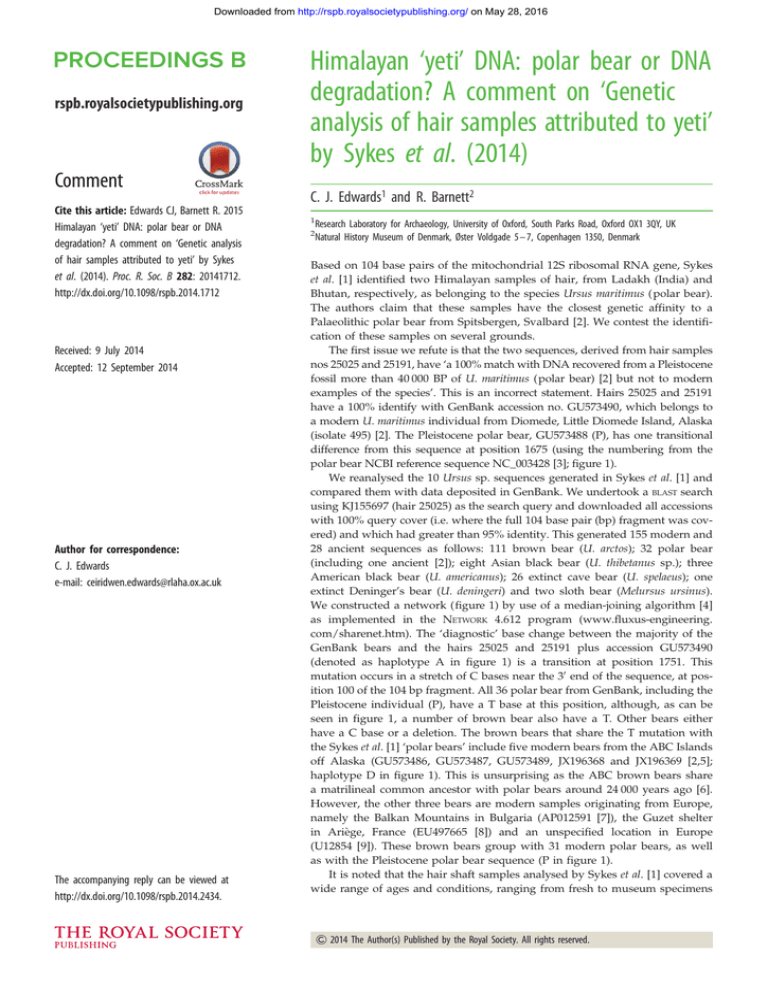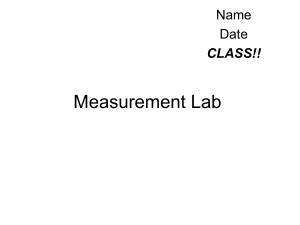
Downloaded from http://rspb.royalsocietypublishing.org/ on May 28, 2016
rspb.royalsocietypublishing.org
Comment
Cite this article: Edwards CJ, Barnett R. 2015
Himalayan ‘yeti’ DNA: polar bear or DNA
degradation? A comment on ‘Genetic analysis
of hair samples attributed to yeti’ by Sykes
et al. (2014). Proc. R. Soc. B 282: 20141712.
http://dx.doi.org/10.1098/rspb.2014.1712
Received: 9 July 2014
Accepted: 12 September 2014
Author for correspondence:
C. J. Edwards
e-mail: ceiridwen.edwards@rlaha.ox.ac.uk
The accompanying reply can be viewed at
http://dx.doi.org/10.1098/rspb.2014.2434.
Himalayan ‘yeti’ DNA: polar bear or DNA
degradation? A comment on ‘Genetic
analysis of hair samples attributed to yeti’
by Sykes et al. (2014)
C. J. Edwards1 and R. Barnett2
1
2
Research Laboratory for Archaeology, University of Oxford, South Parks Road, Oxford OX1 3QY, UK
Natural History Museum of Denmark, Øster Voldgade 5– 7, Copenhagen 1350, Denmark
Based on 104 base pairs of the mitochondrial 12S ribosomal RNA gene, Sykes
et al. [1] identified two Himalayan samples of hair, from Ladakh (India) and
Bhutan, respectively, as belonging to the species Ursus maritimus ( polar bear).
The authors claim that these samples have the closest genetic affinity to a
Palaeolithic polar bear from Spitsbergen, Svalbard [2]. We contest the identification of these samples on several grounds.
The first issue we refute is that the two sequences, derived from hair samples
nos 25025 and 25191, have ‘a 100% match with DNA recovered from a Pleistocene
fossil more than 40 000 BP of U. maritimus (polar bear) [2] but not to modern
examples of the species’. This is an incorrect statement. Hairs 25025 and 25191
have a 100% identify with GenBank accession no. GU573490, which belongs to
a modern U. maritimus individual from Diomede, Little Diomede Island, Alaska
(isolate 495) [2]. The Pleistocene polar bear, GU573488 (P), has one transitional
difference from this sequence at position 1675 (using the numbering from the
polar bear NCBI reference sequence NC_003428 [3]; figure 1).
We reanalysed the 10 Ursus sp. sequences generated in Sykes et al. [1] and
compared them with data deposited in GenBank. We undertook a BLAST search
using KJ155697 (hair 25025) as the search query and downloaded all accessions
with 100% query cover (i.e. where the full 104 base pair (bp) fragment was covered) and which had greater than 95% identity. This generated 155 modern and
28 ancient sequences as follows: 111 brown bear (U. arctos); 32 polar bear
(including one ancient [2]); eight Asian black bear (U. thibetanus sp.); three
American black bear (U. americanus); 26 extinct cave bear (U. spelaeus); one
extinct Deninger’s bear (U. deningeri) and two sloth bear (Melursus ursinus).
We constructed a network (figure 1) by use of a median-joining algorithm [4]
as implemented in the NETWORK 4.612 program (www.fluxus-engineering.
com/sharenet.htm). The ‘diagnostic’ base change between the majority of the
GenBank bears and the hairs 25025 and 25191 plus accession GU573490
(denoted as haplotype A in figure 1) is a transition at position 1751. This
mutation occurs in a stretch of C bases near the 30 end of the sequence, at position 100 of the 104 bp fragment. All 36 polar bear from GenBank, including the
Pleistocene individual (P), have a T base at this position, although, as can be
seen in figure 1, a number of brown bear also have a T. Other bears either
have a C base or a deletion. The brown bears that share the T mutation with
the Sykes et al. [1] ‘polar bears’ include five modern bears from the ABC Islands
off Alaska (GU573486, GU573487, GU573489, JX196368 and JX196369 [2,5];
haplotype D in figure 1). This is unsurprising as the ABC brown bears share
a matrilineal common ancestor with polar bears around 24 000 years ago [6].
However, the other three bears are modern samples originating from Europe,
namely the Balkan Mountains in Bulgaria (AP012591 [7]), the Guzet shelter
in Ariège, France (EU497665 [8]) and an unspecified location in Europe
(U12854 [9]). These brown bears group with 31 modern polar bears, as well
as with the Pleistocene polar bear sequence (P in figure 1).
It is noted that the hair shaft samples analysed by Sykes et al. [1] covered a
wide range of ages and conditions, ranging from fresh to museum specimens
& 2014 The Author(s) Published by the Royal Society. All rights reserved.
Downloaded from http://rspb.royalsocietypublishing.org/ on May 28, 2016
2
1679
T at
position
P
1751
1685
1713 1676
1678
1675
A
B
C at position 1751
1747
deletion at
position
1751
1677
1699
1696
C
Figure 1. Median-joining network analysis of the 104 bp region of the of the mitochondrial 12S ribosomal RNA gene. The colours denote which species the samples
belong to: turquoise, polar bear; red, brown bear; black, American black bear; white, Asian black bear; green, cave bear ( plus one Deninger’s bear); purple, sloth
bear. For information on sample sizes, see main text. Circle areas are proportional to the number of individuals possessing each mitochondrial haplotype. Named
haplotypes are as follows: A, hair samples 25025 and 25191, plus one modern polar bear (GU573490); B, hair samples 25027 and 25194, plus 96 brown bear from
GenBank and one Asian black bear (AB302321); C, hair samples 25028, 25074, 25082, 25104, 25106 and 25202, plus three American black bear (AF303109,
JX196366 and Y08520); D, five brown bear from the ABC Islands (see main text for accession numbers). The position of the Pleistocene polar bear GU573488
[2] is noted by a P and is one transition away from haplotype A. The positions of the nucleotide substitutions that distinguish the haplotypes are shown,
using the numbering from the polar bear NCBI reference sequence NC_003428 [3]. All mutational differences are transitions, apart from 1747 (underlined),
which is a transversion. One unsampled intermediate node is demarked by a small point.
more than 50 years old. Sample no. 25025 came from a group
of hairs collected over 40 years ago, whereas the age
of sample no. 25191, a single hair, is not documented. The
fact that these samples are not modern technically makes
them historic DNA, which is a sub-group of ancient DNA.
Ancient DNA is any DNA that has undergone autolytic or
diagenetic processes, such as oxidation (which causes chemical modification of sugar residues and pyrimidine bases),
endogenous hydrolysis (which occurs rapidly after death
and breaks phosphodiester and glycosidic bonds), breakage
of strands and formation of cross-links [10]. These damages
may prevent useful sequence data being obtained or can, in
some instances, give false results.
This being said, hair is generally considered to be a good
source of ancient DNA as it can be decontaminated easily to
remove exogenous DNA [11]. Sykes et al. [1] state that the
hair shaft samples were thoroughly cleaned to remove surface contamination, but they do not go into details as to
what this cleaning entailed. The diagnostic mutation that separates modern brown bears from modern polar bears occurs
at position 1751 (figure 1) and, as mentioned, is a C/T transition. This base change sits in the middle of a run of six C
bases, which is exactly the place to expect a damage artefact.
Deamination of C (cytosine) to U (uracil) is the major mechanism leading to miscoding lesions in ancient DNA [10] and
causes C to T substitutions. One way to determine whether
the T base seen in hairs 25025 and 25191 is real, and not an
artefact of DNA degradation, would be to impose the basic
criteria for analysis of ancient DNA (e.g. [12]). While we
understand that replication of the samples may be impossible
(especially due to 25191 being from a single hair), the direct
PCR results should have been verified by cloning of the
amplified products, which would determine whether the
C/T mutation is correct and not due to a damage-induced
error in sequencing. Additional PCRs could also have been
attempted from the extracts to build a consensus sequence
for each sample. We would contend that this should have
been standard practice when dealing with a controversial
result, such as that reported by Sykes et al. [1].
Assuming that the single-base change that made Sykes et al.
[1] assign the hairs 25025 and 25191 as polar bear is a damage
artefact, we should like to propose an alternative origin for the
hair samples from Ladakh and Bhutan. The Himalayan bear
(U. arctos isabellinus) is a sub-species of the brown bear that
lives in the higher reaches of the Himalayas (ca 3000 to
5500 m), in remote, mountainous areas of Pakistan, Nepal,
Tibet, Bhutan and India. Its populations are small and isolated,
and it is extremely rare in many parts of its range [13]. The
common name for these bears in the region is Dzu-teh, a Nepalese term meaning ‘cattle bear’, and they have long been
associated with the myth of the yeti [14]. They are usually
sandy or reddish-brown in colour. As the two hair samples
tested by Sykes et al. [1] were golden-brown (Ladakh, 25025)
and reddish-brown (Bhutan, 25191), and as the most parsimonious explanation of the sequences recovered is that they came
from brown bear and exhibit DNA degradation, we would contend that the hair samples are, in fact, from Himalayan brown
bears and not from ‘a previously unrecognized bear species,
colour variants of U. maritimus, or U. arctos/U. maritimus
hybrids’ as claimed.
Proc. R. Soc. B 282: 20141712
1751
rspb.royalsocietypublishing.org
1681
D
Downloaded from http://rspb.royalsocietypublishing.org/ on May 28, 2016
References
2.
4.
5.
6.
7.
8.
9.
Miller W et al. 2012 Polar and brown bear genomes
reveal ancient admixture and demographic footprints
of past climate change. Proc. Natl Acad. Sci. USA 109,
E2382–E2390. (doi:10.1073/pnas.1210506109)
Edwards CJ et al. 2011 Ancient hybridization and an
Irish origin for the modern polar bear matriline. Curr.
Biol. 21, 1251–1258. (doi:10.1016/j.cub.2011.05.058)
Hirata D et al. 2013 Molecular phylogeography of
the brown bear (Ursus arctos) in northeastern Asia
based on analyses of complete mitochondrial DNA
sequences. Mol. Biol. Evol. 30, 1644 –1652. (doi:10.
1093/molbev/mst077)
Bon C et al. 2008 Deciphering the complete
mitochondrial genome and phylogeny of the extinct
cave bear in the Paleolithic painted cave of Chauvet.
Proc. Natl Acad. Sci. USA 105, 17 447–17 452.
(doi:10.1073/pnas.0806143105)
Lento GM, Hickson RE, Chambers GK, Penny D. 1995
Use of spectral analysis to test hypotheses on the
10.
11.
12.
13.
14.
origin of pinnipeds. Mol. Biol. Evol. 12, 28 –52.
(doi:10.1093/oxfordjournals.molbev.a040189)
Dabney J, Meyer M, Pääbo S. 2013 Ancient DNA
damage. Cold Spring Harb. Perspect. Biol. 5,
a012567. (doi:10.1101/cshperspect.a012567)
Gilbert MT et al. 2004 Ancient mitochondrial DNA
from hair. Curr. Biol. 14, R463 –R464. (doi:10.1016/
j.cub.2004.06.008)
Cooper A, Poinar HN. 2000 Ancient DNA: do it right
or not at all. Science 289, 1139. (doi:10.1126/
science.289.5482.1139b)
Nawaz MA, Martin J, Swenson JE. 2014 Identifying
key habitats to conserve the threatened brown bear
in the Himalaya. Biol. Conserv. 170, 198–206.
(doi:10.1016/j.biocon.2013.12.031)
Loxton D, Prothero DR. 2013 Abominable
science: origins of the yeti, Nessie, and other
famous cryptids. New York, NY: Columbia
University Press.
Proc. R. Soc. B 282: 20141712
3.
Sykes BC, Mullis RA, Hagenmuller C, Melton TW,
Sartori M. 2014 Genetic analysis of hair samples
attributed to yeti, bigfoot and other anomalous
primates. Proc. R. Soc. B 281, 20140161. (doi:10.
1098/rspb.2014.0161)
Lindqvist C et al. 2010 Complete mitochondrial
genome of a Pleistocene jawbone unveils
the origin of polar bear. Proc. Natl Acad. Sci.
USA 107, 5053–5057. (doi:10.1073/pnas.
0914266107)
Delisle I, Strobeck C. 2002 Conserved primers for
rapid sequencing of the complete mitochondrial
genome from carnivores, applied to three species of
bears. Mol. Biol. Evol. 19, 357– 361. (doi:10.1093/
oxfordjournals.molbev.a004090)
Bandelt H-J, Forster P, Röhl A. 1999 Median-joining
networks for inferring intraspecific phylogenies.
Mol. Biol. Evol. 16, 37– 48. (doi:10.1093/
oxfordjournals.molbev.a026036)
rspb.royalsocietypublishing.org
1.
3



